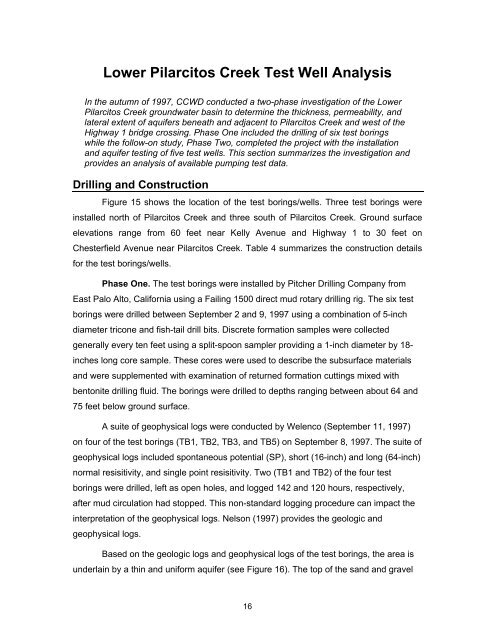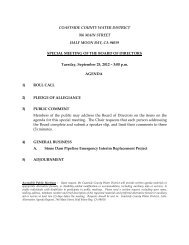Lower Pilarcitos Creek Groundwater Basin Study - Coastside ...
Lower Pilarcitos Creek Groundwater Basin Study - Coastside ...
Lower Pilarcitos Creek Groundwater Basin Study - Coastside ...
Create successful ePaper yourself
Turn your PDF publications into a flip-book with our unique Google optimized e-Paper software.
<strong>Lower</strong> <strong>Pilarcitos</strong> <strong>Creek</strong> Test Well Analysis<br />
In the autumn of 1997, CCWD conducted a two-phase investigation of the <strong>Lower</strong><br />
<strong>Pilarcitos</strong> <strong>Creek</strong> groundwater basin to determine the thickness, permeability, and<br />
lateral extent of aquifers beneath and adjacent to <strong>Pilarcitos</strong> <strong>Creek</strong> and west of the<br />
Highway 1 bridge crossing. Phase One included the drilling of six test borings<br />
while the follow-on study, Phase Two, completed the project with the installation<br />
and aquifer testing of five test wells. This section summarizes the investigation and<br />
provides an analysis of available pumping test data.<br />
Drilling and Construction<br />
Figure 15 shows the location of the test borings/wells. Three test borings were<br />
installed north of <strong>Pilarcitos</strong> <strong>Creek</strong> and three south of <strong>Pilarcitos</strong> <strong>Creek</strong>. Ground surface<br />
elevations range from 60 feet near Kelly Avenue and Highway 1 to 30 feet on<br />
Chesterfield Avenue near <strong>Pilarcitos</strong> <strong>Creek</strong>. Table 4 summarizes the construction details<br />
for the test borings/wells.<br />
Phase One. The test borings were installed by Pitcher Drilling Company from<br />
East Palo Alto, California using a Failing 1500 direct mud rotary drilling rig. The six test<br />
borings were drilled between September 2 and 9, 1997 using a combination of 5-inch<br />
diameter tricone and fish-tail drill bits. Discrete formation samples were collected<br />
generally every ten feet using a split-spoon sampler providing a 1-inch diameter by 18-<br />
inches long core sample. These cores were used to describe the subsurface materials<br />
and were supplemented with examination of returned formation cuttings mixed with<br />
bentonite drilling fluid. The borings were drilled to depths ranging between about 64 and<br />
75 feet below ground surface.<br />
A suite of geophysical logs were conducted by Welenco (September 11, 1997)<br />
on four of the test borings (TB1, TB2, TB3, and TB5) on September 8, 1997. The suite of<br />
geophysical logs included spontaneous potential (SP), short (16-inch) and long (64-inch)<br />
normal resisitivity, and single point resisitivity. Two (TB1 and TB2) of the four test<br />
borings were drilled, left as open holes, and logged 142 and 120 hours, respectively,<br />
after mud circulation had stopped. This non-standard logging procedure can impact the<br />
interpretation of the geophysical logs. Nelson (1997) provides the geologic and<br />
geophysical logs.<br />
Based on the geologic logs and geophysical logs of the test borings, the area is<br />
underlain by a thin and uniform aquifer (see Figure 16). The top of the sand and gravel<br />
16



